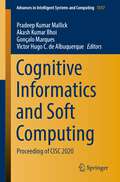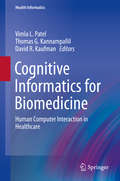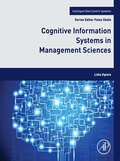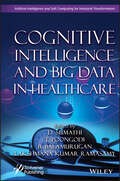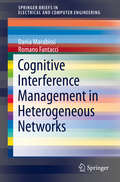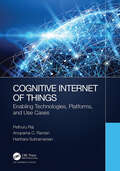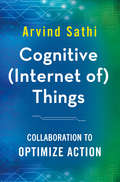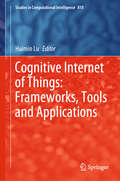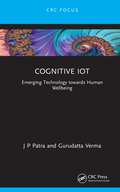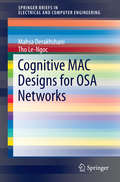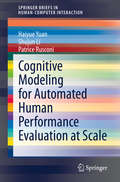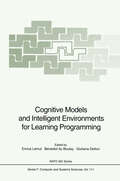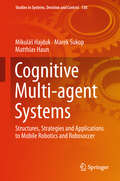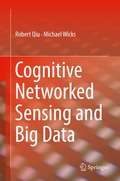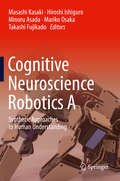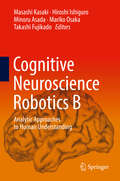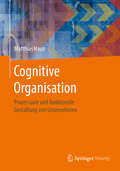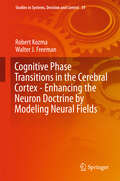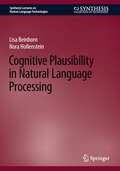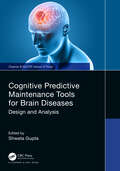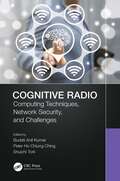- Table View
- List View
Cognitive Informatics and Soft Computing: Proceeding of CISC 2020 (Advances in Intelligent Systems and Computing #1317)
by Pradeep Kumar Mallick Akash Kumar Bhoi Gonçalo Marques Victor Hugo C. de AlbuquerqueThis book presents best selected research papers presented at the 3rd International Conference on Cognitive Informatics and Soft Computing (CISC 2020), held at Balasore College of Engineering & Technology, Balasore, Odisha, India, from 12 to 13 December 2020. It highlights, in particular, innovative research in the fields of cognitive informatics, cognitive computing, computational intelligence, advanced computing, and hybrid intelligent models and applications. New algorithms and methods in a variety of fields are presented, together with solution-based approaches. The topics addressed include various theoretical aspects and applications of computer science, artificial intelligence, cybernetics, automation control theory, and software engineering.
Cognitive Informatics for Biomedicine: Human Computer Interaction in Healthcare (Health Informatics)
by Vimla L. Patel Thomas G. Kannampallil David R. KaufmanThe book reports on the current state on HCI in biomedicine and health care, focusing on the role of human factors, patient safety well as methodological underpinnings of HCI theories and its application for biomedical informatics. Theories, models and frameworks for human-computer interaction (HCI) have been recognized as key contributors for the design, development and use of computer-based systems. In the clinical domain, key themes that litter the research landscape of health information technology (HIT) are usability, decision support and clinical workflow – all of which are affected directly or indirectly by the nature of HCI. While the implications of HCI principles for the design of HIT are acknowledged, the adoption of the tools and techniques among clinicians, informatics researchers and developers of HIT are limited. There is a general consensus that HIT has not realized its potential as a tool to facilitate clinical decision-making, the coordination of care and improves patient safety. Embracing sound principles of iterative design can yield significant dividends. It can also enhance practitioner’s abilities to meet “meaningful use” requirements. The purpose of the book is two-fold: to address key gaps on the applicability of theories, models and evaluation frameworks of HCI and human factors for research in biomedical informatics. It highlights the state of the art, drawing from the current research in HCI. Second, it also serves as a graduate level textbook highlighting key topics in HCI relevant for biomedical informatics, computer science and social science students working in the healthcare domain. For instructional purposes, the book provides additional information and a set of questions for interactive class discussion for each section. The purpose of these questions is to encourage students to apply the learned concepts to real world healthcare problems.
Cognitive Information Systems in Management Sciences (Intelligent Data-Centric Systems: Sensor Collected Intelligence)
by Lidia Dominika OgielaCognitive Information Systems in Management Sciences summarizes the body of work in this area, taking an analytical approach to interpreting the data, while also providing an approach that can be used for practical implementation in the fields of computing, economics, and engineering. Using numerous illustrative examples, and following both theoretical and practical results, Dr. Lidia Ogiela discusses the concepts and principles of cognitive information systems, the relationship between intelligent computer data analysis, and how to utilize computational intelligent approaches to enhance information retrieval. Real world implantation use cases round out the book, with valuable scenarios covering management science, computer science, and engineering. Indexing: The books of this series are submitted to EI-Compendex and SCOPUSDiscusses the basic concepts and principles in cognitive information systems, providing ‘real-world' implementation examplesExplains the relationship between intelligent computer data analysis and how to utilize computational intelligent approaches to enhance information retrievalProvides a unified structured approach that can be used to develop information flow in cognitive management systems
Cognitive Intelligence and Big Data in Healthcare (Artificial Intelligence and Soft Computing for Industrial Transformation)
by D. Sumathi T. Poongodi B. Balamurugan Lakshmana Kumar RamasamyCOGNITIVE INTELLIGENCE AND BIG DATA IN HEALTHCARE Applications of cognitive intelligence, advanced communication, and computational methods can drive healthcare research and enhance existing traditional methods in disease detection and management and prevention. As health is the foremost factor affecting the quality of human life, it is necessary to understand how the human body is functioning by processing health data obtained from various sources more quickly. Since an enormous amount of data is generated during data processing, a cognitive computing system could be applied to respond to queries, thereby assisting in customizing intelligent recommendations. This decision-making process could be improved by the deployment of cognitive computing techniques in healthcare, allowing for cutting-edge techniques to be integrated into healthcare to provide intelligent services in various healthcare applications. This book tackles all these issues and provides insight into these diversified topics in the healthcare sector and shows the range of recent innovative research, in addition to shedding light on future directions in this area. Audience The book will be very useful to a wide range of specialists including researchers, engineers, and postgraduate students in artificial intelligence, bioinformatics, information technology, as well as those in biomedicine.
Cognitive Intelligence and Big Data in Healthcare (Artificial Intelligence and Soft Computing for Industrial Transformation)
by D. Sumathi T. Poongodi S. Balamurugan R. Lakshmana KumarCOGNITIVE INTELLIGENCE AND BIG DATA IN HEALTHCARE Applications of cognitive intelligence, advanced communication, and computational methods can drive healthcare research and enhance existing traditional methods in disease detection and management and prevention. As health is the foremost factor affecting the quality of human life, it is necessary to understand how the human body is functioning by processing health data obtained from various sources more quickly. Since an enormous amount of data is generated during data processing, a cognitive computing system could be applied to respond to queries, thereby assisting in customizing intelligent recommendations. This decision-making process could be improved by the deployment of cognitive computing techniques in healthcare, allowing for cutting-edge techniques to be integrated into healthcare to provide intelligent services in various healthcare applications. This book tackles all these issues and provides insight into these diversified topics in the healthcare sector and shows the range of recent innovative research, in addition to shedding light on future directions in this area. Audience The book will be very useful to a wide range of specialists including researchers, engineers, and postgraduate students in artificial intelligence, bioinformatics, information technology, as well as those in biomedicine.
Cognitive Interference Management in Heterogeneous Networks (SpringerBriefs in Electrical and Computer Engineering)
by Dania Marabissi Romano FantacciThis brief investigates the role of interference management in Heterogeneous Networks (Het Nets), focusing on cognitive approaches and the use of beamforming. Key concepts of Het Nets are introduced and different deployment strategies are examined, such as sharing the same frequency band of the macro cells or using new high frequency bands. Particular attention is devoted to co-channel deployment and to the problem of interference management, addressing various strategies that can be adopted to handle the interference between the cells. In addition, the brief explores cognitive small cells which are able to avoid or limit interference by using suitable beamforming and resource allocation schemes. The suggested solutions are supported by numerical results in terms of performance evaluations and comparisons.
Cognitive Internet of Things: Enabling Technologies, Platforms, and Use Cases
by Pethuru Raj Anupama C. Raman Harihara SubramanianThe Internet of Things (IoT) concept is defined as a flexible and futuristic network where all the different types of devices and smart objects can become seamlessly connected to each other and can actively participate in all types of processes which are happening around us. The grand objective of making physical, mechanical, electrical, and electronic devices to use the deeper and extreme connectivity and service-enablement techniques is to make them intelligent in their deeds, decisions, and deals. Cognitive IoT is the application of cognitive computing technologies to the data which is generated by the connected devices of the IoT ecosystem. Cognition means thinking; however, computers are not yet fully capable of mimicking human like thought. However, the present-day computer systems can perform some functions which are like the capability of human beings to think. Cognitive Internet of Things: Enabling Technologies, Platforms, and Use Cases explains the concepts surrounding Cognitive IoT. It also looks at the use cases and such supporting technologies as artificial intelligence and machine learning that act as key enablers of Cognitive IoT ecosystem. Different Cognitive IoT enabled platforms like IBM Watson and other product specific use cases like Amazon Alexa are covered in depth. Other highlights of the book include: Demystifying the cognitive computing paradigm Delineating the key capabilities of cognitive cloud environments Deep learning algorithms for cognitive IoT solutions Natural language processing (NLP) methods for cognitive IoT systems Designing a secure infrastructure for cognitive IoT platforms and applications
Cognitive Internet of Things: Enabling Technologies, Platforms, and Use Cases
by Pethuru Raj Anupama C. Raman Harihara SubramanianThe Internet of Things (IoT) concept is defined as a flexible and futuristic network where all the different types of devices and smart objects can become seamlessly connected to each other and can actively participate in all types of processes which are happening around us. The grand objective of making physical, mechanical, electrical, and electronic devices to use the deeper and extreme connectivity and service-enablement techniques is to make them intelligent in their deeds, decisions, and deals. Cognitive IoT is the application of cognitive computing technologies to the data which is generated by the connected devices of the IoT ecosystem. Cognition means thinking; however, computers are not yet fully capable of mimicking human like thought. However, the present-day computer systems can perform some functions which are like the capability of human beings to think. Cognitive Internet of Things: Enabling Technologies, Platforms, and Use Cases explains the concepts surrounding Cognitive IoT. It also looks at the use cases and such supporting technologies as artificial intelligence and machine learning that act as key enablers of Cognitive IoT ecosystem. Different Cognitive IoT enabled platforms like IBM Watson and other product specific use cases like Amazon Alexa are covered in depth. Other highlights of the book include: Demystifying the cognitive computing paradigm Delineating the key capabilities of cognitive cloud environments Deep learning algorithms for cognitive IoT solutions Natural language processing (NLP) methods for cognitive IoT systems Designing a secure infrastructure for cognitive IoT platforms and applications
Cognitive (Internet of) Things: Collaboration to Optimize Action
by Arvind SathiThis book explores cognitive behavior among Internet of Things. Using a series of current and futuristic examples – appliances, personal assistants, robots, driverless cars, customer care, engineering, monetization, and many more – the book covers use cases, technology and communication aspects of how machines will support individuals and organizations. This book examines the Cognitive Things covering a number of important questions: • What are Cognitive Things? • What applications can be driven from Cognitive Things – today and tomorrow? • How will these Cognitive Things collaborate with each and other, with individuals and with organizations? • What is the cognitive era? How is it different from the automation era? • How will the Cognitive Things support or accelerate human problem solving? • Which technical components make up cognitive behavior? • How does it redistribute the work-load between humans and machines? • What types of data can be collected from them and shared with external organizations? • How do they recognize and authenticate authorized users? How is the data safeguarded from potential theft? Who owns the data and how are the data ownership rights enforced? Overall, Sathi explores ways in which Cognitive Things bring value to individuals as well as organizations and how to integrate the use of the devices into changing organizational structures. Case studies are used throughout to illustrate how innovators are already benefiting from the initial explosion of devices and data. Business executives, operational managers, and IT professionals will understand the fundamental changes required to fully benefit from cognitive technologies and how to utilize them for their own success.
Cognitive Internet of Things: Frameworks, Tools and Applications (Studies in Computational Intelligence #810)
by Huimin LuThis book provides insights into the research in the fields of artificial intelligence in combination with Internet of Things (IoT) technologies. Today, the integration of artificial intelligence and IoT technologies is attracting considerable interest from both researchers and developers from academic fields and industries around the globe. It is foreseeable that the next generation of IoT research will focus on artificial intelligence/beyond artificial intelligence approaches. The rapidly growing numbers of artificial intelligence algorithms and big data solutions have significantly increased the number of potential applications for IoT technologies, but they have also created new challenges for the artificial intelligence community. This book shares the latest scientific advances in this area.
Cognitive IoT: Emerging Technology towards Human Wellbeing (Intelligent Signal Processing and Data Analysis)
by J P Patra Gurudatta VermaThis book deals with a different research area of cognitive IoT and explains how machine learning algorithms can be applied for cognitive IoT. It deals with applications of cognitive IoT in this pandemic (COVID-19), applications for student performance evaluation, applications for human healthcare for chronic disease prediction, use of wearable sensors and review regarding their energy optimization and how cognitive IoT helps in farming through rainfall prediction and prediction of lake levels. Features: Describes how cognitive IoT is helpful for chronic disease prediction and processing of data gathered from healthcare devices Explains different sensors available for health monitoring Explores application of cognitive IoT in COVID-19 analysis Discusses pertinent and efficient farming applications for sustaining agricultural growth Reviews smart educational aspects such as student response, performance, and behavior and instructor response, performance, and behavior This book aims at researchers, professionals and graduate students in Computer Science and Engineering, Computer Applications and Electronics Engineering, and Wireless Communications and Networking.
Cognitive IoT: Emerging Technology towards Human Wellbeing (Intelligent Signal Processing and Data Analysis)
by J P Patra Gurudatta VermaThis book deals with a different research area of cognitive IoT and explains how machine learning algorithms can be applied for cognitive IoT. It deals with applications of cognitive IoT in this pandemic (COVID-19), applications for student performance evaluation, applications for human healthcare for chronic disease prediction, use of wearable sensors and review regarding their energy optimization and how cognitive IoT helps in farming through rainfall prediction and prediction of lake levels. Features: Describes how cognitive IoT is helpful for chronic disease prediction and processing of data gathered from healthcare devices. Explains different sensors available for health monitoring. Explores application of cognitive IoT in COVID-19 analysis. Discusses pertinent and efficient farming applications for sustaining agricultural growth. Reviews smart educational aspects such as student response, performance, and behavior and instructor response, performance, and behavior. This book aims at researchers, professionals and graduate students in Computer Science and Engineering, Computer Applications and Electronics Engineering, and Wireless Communications and Networking.
Cognitive MAC Designs for OSA Networks (SpringerBriefs in Electrical and Computer Engineering)
by Mahsa Derakhshani Tho Le-NgocThis SpringerBrief presents recent advances in the cognitive MAC designs for opportunistic spectrum access (OSA) networks. It covers the basic MAC functionalities and MAC enhancements of IEEE 802.11. Later chapters discuss the existing MAC protocols for OSA and classify them based on characteristic features.The authors provide new research in adaptive carrier sensing-based MAC designs tailored for OSA, which optimize spectrum utilization and ensure a peaceful coexistence of licensed and unlicensed systems. Analytically devised via optimization and game-theoretic approaches, these adaptive MAC designs are shown to effectively reduce collisions between both primary and secondary network users.Researchers and professionals working in wireless communications and networks will find this content valuable. This brief is also a useful study guide for advanced-level students in computer science and electrical engineering.
Cognitive Modeling for Automated Human Performance Evaluation at Scale (Human–Computer Interaction Series)
by Haiyue Yuan Shujun Li Patrice RusconiCognitive models and software tools have been widely used for both research and commercial purposes. Although they have proved very useful, there are some limitations preventing large-scale modeling and simulation tasks to be carried out efficiently and effectively. In this book, we aim to provide readers with a systematic overview of state-of-the-art cognitive modeling software tools and applications and an introduction to a new software framework for facilitating large-scale modeling and simulation of human-performance tasks. The authors first review cognitive modeling theories and then present an overview of state-of-the-art software tools for cognitive modeling and simulation. Finally, the book focuses on the new software framework and a research prototype called CogTool+, including how to incorporate behavioral data such as eye-tracking data in modeling and simulation tasks. Typical applications of CogTool+ in HCI and cyber security are given to demonstrate its usefulness.
Cognitive Models and Intelligent Environments for Learning Programming (NATO ASI Subseries F: #111)
by Enrica Lemut Benedict Du Boulay Giuliana DettoriAt present, there is a general consensus on the nature of learning programming, but there are different opinions on what forms an effective environment for it. It is generally recognized that the development of a mental model is a formidable task for the student and that learning programming is a complex activity that depends heavily on metacognitive skills. This book, based on a NATO workshop, presents both pure cognitive models and experimental learning environments, and discusses what characteristics can make a learning model effective, especially in relation to the learning environment (natural or computerized). The papers cover cognitive models related to different aspects of programming, classes of learners, and types of environment, and are organized in three groups: theoretical and empirical studies on understanding programming, environments for learning programming, and learning programming in school environments. Comprehension, design, construction, testing, debugging, and verification are recognized as interdependent skills, which require complicated analysis and may develop independently, and indifferent orders, in novices. This book shows that there is unlikely to be asingle path from novice to expert and that the structure of the final product (the program) may not constrain the process by which it comes into being as much as some would advocate.
Cognitive Multi-agent Systems: Structures, Strategies and Applications to Mobile Robotics and Robosoccer (Studies in Systems, Decision and Control #138)
by Mikuláš Hajduk Marek Sukop Matthias HaunThe book describes an approach to the multi-agent systems (MAS) design for applications of robotic soccer in the MiroSot category. The described MAS is designed for dynamic, quickly changing environments, in which not only the actions of our MAS are observed, but also those of the opposing MAS. It actively tries to affect the environment to score goals faster than the opposing MAS. Multi-agent systems (MAS) are mostly applied in the environments in which they exist and act without an opposing system. The book also describes strategies based on a supervisor that makes decisions depending on behavior prediction of the opposing MAS and the ball movement in the working place. A sophisticated distribution of tasks was designed for each agent to cooperate in order score goals as fast as possible. Simultaneously, these agents try, by permitted means, to prevent the enemy agents from scoring goals. The approach described is an excellent guide to the constantly evolving abilities of mobile robotics, both for real-world applications, such as cooperation of multiple robots in life-saving activities, and for the steadily developing applications of mobile robots in various robotic competitions (e.g. Robocup, etc.). The book provides readers with high-level knowledge on how to design strategies and how to implement such systems, and the ideas presented enable them to further refine the approach utilizing the latest hardware and use it in new systems implementations of sophisticated intelligent engineering.
Cognitive Networked Sensing and Big Data
by Robert Qiu Michael WicksWireless Distributed Computing and Cognitive Sensing defines high-dimensional data processing in the context of wireless distributed computing and cognitive sensing. This book presents the challenges that are unique to this area such as synchronization caused by the high mobility of the nodes. The author will discuss the integration of software defined radio implementation and testbed development. The book will also bridge new research results and contextual reviews. Also the author provides an examination of large cognitive radio network; hardware testbed; distributed sensing; and distributed computing.
Cognitive Neuroscience Robotics A: Synthetic Approaches to Human Understanding
by Masashi Kasaki Hiroshi Ishiguro Minoru Asada Mariko Osaka Takashi FujikadoCognitive Neuroscience Robotics is the first introductory book on this new interdisciplinary area. This book consists of two volumes, the first of which, Synthetic Approaches to Human Understanding, advances human understanding from a robotics or engineering point of view. The second, Analytic Approaches to Human Understanding, addresses related subjects in cognitive science and neuroscience. These two volumes are intended to complement each other in order to more comprehensively investigate human cognitive functions, to develop human-friendly information and robot technology (IRT) systems, and to understand what kind of beings we humans are. Volume A describes how human cognitive functions can be replicated in artificial systems such as robots, and investigates how artificial systems could acquire intelligent behaviors through interaction with others and their environment.
Cognitive Neuroscience Robotics B: Analytic Approaches to Human Understanding
by Masashi Kasaki Hiroshi Ishiguro Minoru Asada Mariko Osaka Takashi FujikadoCognitive Neuroscience Robotics is the first introductory book on this new interdisciplinary area. This book consists of two volumes, the first of which, Synthetic Approaches to Human Understanding, advances human understanding from a robotics or engineering point of view. The second, Analytic Approaches to Human Understanding, addresses related subjects in cognitive science and neuroscience. These two volumes are intended to complement each other in order to more comprehensively investigate human cognitive functions, to develop human-friendly information and robot technology (IRT) systems, and to understand what kind of beings we humans are. Volume B describes to what extent cognitive science and neuroscience have revealed the underlying mechanism of human cognition, and investigates how development of neural engineering and advances in other disciplines could lead to deep understanding of human cognition.
Cognitive Organisation: Prozessuale und funktionale Gestaltung von Unternehmen
by Matthias HaunDie in dem Buch beschriebenen Methoden und Techniken sichern Unternehmen den Entwicklungsvorsprung, der benötigt wird, um mit hoher Innovations- und Zukunftssicherheit in organisatorischer und technologischer Hinsicht auf dynamischen Märkten zu bestehen.Der innovative Ansatz stellt die Begriffe Kognition, Organisation, Wissen und Technologie in den Mittelpunkt. Mit Hilfe der wissensbasierten, handlungsorientierten und simulationsvalidierten Methodik können innovative Unternehmen als kognitive, wandelbare Organisationen entwickelt werden.
Cognitive Phase Transitions in the Cerebral Cortex - Enhancing the Neuron Doctrine by Modeling Neural Fields (Studies in Systems, Decision and Control #39)
by Robert Kozma Walter J. FreemanThis intriguing book was born out of the many discussions the authors had in the past 10 years about the role of scale-free structure and dynamics in producing intelligent behavior in brains. The microscopic dynamics of neural networks is well described by the prevailing paradigm based in a narrow interpretation of the neuron doctrine. This book broadens the doctrine by incorporating the dynamics of neural fields, as first revealed by modeling with differential equations (K-sets). The book broadens that approach by application of random graph theory (neuropercolation). The book concludes with diverse commentaries that exemplify the wide range of mathematical/conceptual approaches to neural fields. This book is intended for researchers, postdocs, and graduate students, who see the limitations of network theory and seek a beachhead from which to embark on mesoscopic and macroscopic neurodynamics.
Cognitive Plausibility in Natural Language Processing (Synthesis Lectures on Human Language Technologies)
by Lisa Beinborn Nora HollensteinThis book explores the cognitive plausibility of computational language models and why it’s an important factor in their development and evaluation. The authors present the idea that more can be learned about cognitive plausibility of computational language models by linking signals of cognitive processing load in humans to interpretability methods that allow for exploration of the hidden mechanisms of neural models. The book identifies limitations when applying the existing methodology for representational analyses to contextualized settings and critiques the current emphasis on form over more grounded approaches to modeling language. The authors discuss how novel techniques for transfer and curriculum learning could lead to cognitively more plausible generalization capabilities in models. The book also highlights the importance of instance-level evaluation and includes thorough discussion of the ethical considerations that may arise throughout the various stages of cognitive plausibility research.
Cognitive Predictive Maintenance Tools for Brain Diseases: Design and Analysis (Chapman & Hall/CRC Internet of Things)
by Shweta GuptaThis book involves the design, analysis, and application of various cognitive predictive maintenance tests with the help of tools like vibration analysis, ultrasonic analysis, infrared analysis, oil analysis, laser-shaft alignment, and motor circuit analysis in the prediction of various cognitive diseases such as epilepsy, Parkinson’s disease, Alzheimer’s disease, and depression. These are needed since there are no proper medical tests available to predict these diseases in remote areas at an early stage. Various emerging technologies are analyzed for the design of tests. Key features: Incorporates innovative processes for treating cognitive diseases. Early and exact identification and treatment strategies are incorporated. Future technologies like artificial intelligence, machine learning, the IoT, and data science are used to find solutions. Analysis with existing cognitive disease solutions is incorporated and simulations provided. The novelty of the book lies in the accurate prediction of cognitive diseases. Encompassing future technologies and various communication protocols or devices available for cognitive diseases for the design of new equipment are an outcome of the book. Various parameters like power consumption, productivity, and safety should be taken into account during the analysis, design, and application of a product. The book could well be added to the curriculum of medical colleges and biomedical engineering students. Possible vendors include biomedical research centers like Biotechnika and the Indian Council of Medical Research (ICMR). It would be a breakthrough for biomedical companies to launch their new products.
Cognitive Predictive Maintenance Tools for Brain Diseases: Design and Analysis (Chapman & Hall/CRC Internet of Things)
This book involves the design, analysis, and application of various cognitive predictive maintenance tests with the help of tools like vibration analysis, ultrasonic analysis, infrared analysis, oil analysis, laser-shaft alignment, and motor circuit analysis in the prediction of various cognitive diseases such as epilepsy, Parkinson’s disease, Alzheimer’s disease, and depression. These are needed since there are no proper medical tests available to predict these diseases in remote areas at an early stage. Various emerging technologies are analyzed for the design of tests. Key features: Incorporates innovative processes for treating cognitive diseases. Early and exact identification and treatment strategies are incorporated. Future technologies like artificial intelligence, machine learning, the IoT, and data science are used to find solutions. Analysis with existing cognitive disease solutions is incorporated and simulations provided. The novelty of the book lies in the accurate prediction of cognitive diseases. Encompassing future technologies and various communication protocols or devices available for cognitive diseases for the design of new equipment are an outcome of the book. Various parameters like power consumption, productivity, and safety should be taken into account during the analysis, design, and application of a product. The book could well be added to the curriculum of medical colleges and biomedical engineering students. Possible vendors include biomedical research centers like Biotechnika and the Indian Council of Medical Research (ICMR). It would be a breakthrough for biomedical companies to launch their new products.
Cognitive Radio: Computing Techniques, Network Security and Challenges
by Budati Anil KumarThe scarcity of radio spectrum is one of the most urgent issues at the forefront of future network research that is yet to be addressed. To address the problem of spectrum usage efficiency, the cognitive radio (CR) concept was proposed. The challenges of employing CRs include ensuring secure device operations and data transmission with advanced computing techniques. Successful development of CR systems will involve attainment of the following key objectives: Increasing the rate and capacity of CR-based networks How the power is utilized in CR hardware devices with CMOS circuits How the framework is needed in complex networks Vedic multipliers on CR networks Spatial analysis and clustering methods for traffic management To transmit a large volume of data like video compression Swarm optimization algorithms Resource sharing in peer-to-peer networking This book gathers the latest research works focusing on the issues, challenges, and solutions in the field of Cognitive Radio Networks, with various techniques. The chapters in this book will give solutions to the problems that Industry 4.0 faces, and will be an essential resource for scholars in all areas of the field.
